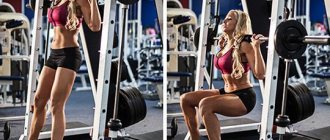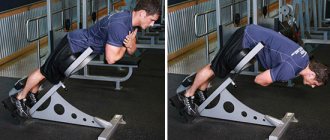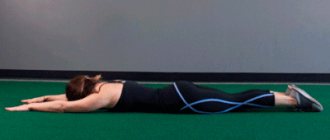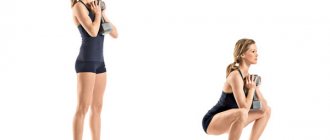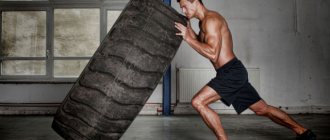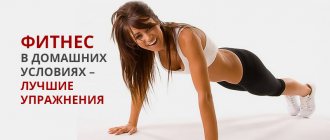Purpose of the exercise
Hyperextension is a fairly simple exercise in technical execution, and its healing effect on the body is enormous.
The main goal of the movement is to develop back extension and form a supporting muscular corset for the spine.
When performing heavy basic exercises, the abdominal and lower back muscles act as the main stabilizers of the body, receiving a high load.
Strong lower back and abs are the key to injury prevention and the key to good sports results. Therefore, in all sports, special attention is paid to their development.
If athletes work out their lower back so as not to injure it during power loads, then ordinary gym goers come to work out to eliminate problems of the musculoskeletal system - with the presence of hernias, protrusions, etc.
The purpose of training is health-improving. Namely, the creation of a muscular corset of the back to reduce or completely eliminate pain.
How to replace hyperextension in the gym and at home, what exercises are similar, analogues
There is an opinion that reverse hyperextension has moved beyond the category of simple exercises aimed at recovery after training.
Fitness trainers claim that this exercise will protect your spine. This is a serious statement, but what hyperextension is actually needed for and how to do it correctly, you will learn in this article.
Reverse hyperextension is an exercise (and machine) that will reduce stress in the lower spine and strengthen the hamstrings, glutes, and quads.
It is usually performed at the end of a heavy workout (especially those involving squats and deadlifts) or as an assistance exercise to strengthen the back muscles.
Here you will learn the correct technique for performing reverse hyperextension on a special machine, fitball, regular bench, and even on the floor.
An alternative to the machine can be a bench press bench or any durable surface like a table.
Benefits of Exercise
Reverse hyperextension is considered safer compared to the classic version - the risks of spinal injuries are practically eliminated. Such training is recommended for back pain or problems with the spine. This exercise is suitable if you have a hernia, protrusion or osteochondrosis of the intervertebral discs.
In addition to the back, the muscles of the legs and buttocks are well used here. Thanks to this, you can use more weight and, as a result, get results faster.
Important! In the gym, always consult with a trainer about the advisability of performing certain exercises. If you have problems with your spine, be sure to tell your trainer and consult your doctor.
Recommendations
Reverse hyperextension is usually performed on the day of back training. Pre-warmed muscles will help avoid injury and make the exercise more effective.
The number of sets and repetitions depends on your fitness level and training goals. However, to strengthen and develop the lower back, a rep range of 12-15 is recommended. The option of performing it until muscle failure is also well recommended (use it when pumping up the lower back after identifying hernias or other problems).
Taking into account the specifics of the lumbar zone, it is enough to do 3-4 sets in one workout. To pump the area - 5-6 approaches.
Working muscles
With reverse hyperextension, mainly the muscles of the posterior surface of the body develop, in particular:
- gluteus maximus muscles;
- back extensors;
- hamstring biceps;
- quadratus lumborum muscles;
- semitendinosus muscles.
In addition, the abdominal muscles perform the function of stabilizing the torso, and the arms work statically.
Pros and cons of the exercise
In fitness, reverse extensions are one of the most beneficial exercises. It is aimed at developing the muscles of the lower back.
The main benefits of the reverse hyperextension exercise:
- Prevention and strengthening of the lower back.
- Preventing the occurrence of intervertebral hernias and other problems in the lumbar region.
- Preparing the back for heavy basic exercises (prevents slowing down progression due to a limiting weak lower back).
Reverse extensions are recommended for anyone who spends long periods of time in a sitting position. This helps keep your back muscles toned and avoid subsequent problems.
disadvantage of hyperextension is the incorrect execution technique. Any mistakes when performing this movement can not only reduce its benefits, but also increase the risk of injury.
Execution technique
Before performing the exercise, you need to choose a surface on which you can lie on your stomach and lower your legs down. The height of the surface should be approximately equal to the length of your legs.
Reverse hyperextension involves the following technique:
- Secure the body with your hands.
- Raise your legs slightly, tensing your buttocks and thighs. Do not relax them from the beginning to the end of the approach.
- Raise your legs as you exhale as high as the stretch allows. Concentrate on your buttocks and thighs.
- Hold your legs in the upper position for a second, and while inhaling, lower them down to the starting position.
- Repeat 12 to 15 times. Do 2-3 sets with rest breaks.
Execution Variations
There is a special simulator for this exercise, but it is not very common in modern gyms. Therefore, the question often arises about what can replace the reverse hyperextension machine. In fact, this exercise can be performed on any surface that allows you to achieve the desired body position.
There are such variations:
- on fitball;
- on a bench at an angle of 45°;
- with leg bending.
Workout at home
Not always and not everyone is able to train in the gym. This is due to the following reasons:
- Lack of time to travel to the fitness center.
- Insufficient funds to pay for a subscription, and even more so, for training under the supervision of a coach.
- Complexity due to large crowds of people and shortcomings of one’s own body.
But there is always a way out, if a person really wants to train. It is then that a person looks for opportunities for alternative training and finds it. One option is to study at home. They are divided:
- Classes in the yard, on the sports ground in the warm season.
- Training in an apartment, in a country house or in your own home.
While on the street, on the sports ground you can use (if any) two horizontal parallel pipes located at the same height. You need to lie with your body (across) on them so that your legs hang down freely, holding tightly with your hands to one of them. The technique is the same.
The only negative is that such a projectile is somewhat stiff, and for comfort you need to throw something soft over it.
At home, you can use a couple of chairs, a sofa, a bed or a bench, if you have one.
In the end, you can also practice on the floor, as already mentioned.
Unlike direct hyperextension, an athlete can do without an assistant, although the presence of one creates a certain athletic fervor and a spirit of healthy competition. So we can say with confidence that hyperextension at home is not only possible, but also widely applicable.
Train with a fitball
A fitball is a special ball for performing reverse hyperextension. How to do the exercise:
- You need to lie down with your stomach so that the pelvic part is located in the center of the ball.
- You can hold onto anything with your hands, from heavy dumbbells or weights to a wall bars (if you have one), or the same central heating radiator, pipe, etc.
- The starting position is relaxed, lying on the ball and holding onto reliable support with your hands.
- While inhaling, you need to smoothly raise your legs while simultaneously stretching the toes of your feet. This is how the maximum leg lift is done.
- When lowering your lower limbs, it is important not to relax completely, but only to touch the floor with your toes - the body in this position is a straight line.
The speed of the exercise should coincide with the speed of measured breathing. 5-7 repetitions with two or three approaches will sufficiently work the necessary muscles.
Reverse hyperextension at home
Reverse hyperextension refers to workouts that can be done at home. The technique in this case is slightly different, because... difficult to find a suitable surface. To perform it, you need to lie on the floor, cross your arms behind your back or stretch them along your hips.
Did you know? Reverse hyperextension on the floor is the most gentle workout for the back in the presence of a hernia.
Then you need to raise your legs as high as possible, trying to lift the surface of your thigh off the floor. If it is difficult to hold your arms behind your back, stretch them out in front of you and lift them up at the same time as your legs. You can also perform reverse hyperextension on a fitball at home:
- Lie on your stomach on the ball.
- Place your hands on the floor and maintain your balance.
- Raise and lower your legs as in the classic version.
How to do hyperextension correctly (video)
The hyperextension exercise is a guaranteed vaccine against lower back pain. If you're not doing hyperextensions yet, start! It will protect you from injuries during heavy lifts in deadlifts and squats, restore tone to the lumbar muscles, strengthen the tendons, and at the same time tighten the buttocks and thighs.
How to do hyperextensions on the back and buttocks correctly, how to do hyperextensions at home and what types of hyperextensions there are - in the Soviet Sports guide.
What is hyperextension
Hyperextension (from English “hyperextension”) is an exercise that develops the muscles that straighten the spine. Located along the spinal column, these muscles are responsible for bending and flexion-extension of the back.
The extensor muscles are involved in the basic strength movements of the deadlift and squat. The better the extensors are developed, the greater the weights you will be able to handle in the “base”.
Hyperextensions help get rid of pain and discomfort in the lower back and improve posture. They are recommended as a preventive measure for radiculitis. In addition, the gluteal and hamstring muscles are involved in hyperextensions. Regularly performing hyperextensions will remove fat from the buttocks and thighs - that’s why girls often do this exercise in gyms.
How to do hyperextension correctly
Hyperextension is done on special benches or a “Roman chair” machine - with supports for the pelvis and legs. Adjust the machine so that your pelvis rests on the pillow and the rollers are located above your calves. The pillow should be located at the base of the abdomen, and not higher - otherwise, it will be difficult for you to bend over. The legs should be slightly bent to relieve tension on the knee joints.
Cross your arms over your chest or behind your head. Keeping your back straight, gently bend down to an angle of approximately 45, maximum 90 degrees. Then straighten up so that your legs and body form a straight line.
The correct hyperextension technique can be seen in this video
How to do hyperextension at home
If you don't go to the gym, hyperextensions can be done at home—but you'll need a partner. Lie down on the sofa with your body hanging down. Ask your partner to sit on your feet. With your arms crossed over your chest, tilt your body down and then straighten until it is in a straight line with your legs.
You can also perform hyperextension on the floor - lying on your stomach, stretch your arms and smoothly raise your upper body, contracting your back extensors. We smoothly return to the starting position - the chest does not lie on the floor, but remains slightly raised.
Hyperextensions on the back and buttocks
Depending on the position of the back when performing hyperextensions, the load shifts from one muscle to another. If you want to work your extensor muscles first, keep your back straight as described above. If you need to shift the focus to the gluteal muscles and hamstrings, round your back while bending and straightening.
To further increase the load on the buttocks, lower the pad of the exercise machine lower - from the waist and pelvis to the legs.
Old nags. A Guide to Forgotten Old School Exercises
Types of hyperextensions
Athletes who have back problems often use reverse hyperextensions. Their difference is that the body is fixed here - you lie on the bench with your stomach and hold on to it. All movement occurs due to the legs: they hang in the air - while inhaling, remaining straight, they go down, while exhaling - they unbend to a straight line with the body.
Another type of exercise is hyperextension on a fitball. It can be used to perform both regular and reverse hyperextensions. In the first case, you need to rest your feet against a wall or other support and lie on the fitball with your pelvis, arms crossed behind your head. In the second, lie down so that you rest your hands on the floor, and your legs remain hanging in the air.
Another type of exercise is hyperextension with weights. For muscle growth, progressive loads are needed, so hyperextensions can be done with weights: hold a barbell or dumbbell in your arms crossed over your chest. A more difficult option is barbell hyperextension: you will need to keep your head slightly elevated so that the bar of the bar does not roll off you in the lower position.
How to include hyperextensions in your training
Perform 3-4 sets of hyperextensions before heavy compound lifts such as squats and deadlifts. Do hyperextensions without weight, in the range of about 15 repetitions - this will warm up the extensor muscles and protect you from injury.
You can perform hyperextensions after the base. Do 3 sets after squats or stiff-legged deadlifts. Take extra weight and gradually build it up. Rep range: 12-15. Performing hyperextensions after the main leg or back exercise will allow you to better work the target muscle.
How to do a French press correctly
Technique for performing hyperextensions at home
To do hyperextension at home without a machine, you will need a training partner and a high, flat surface. Usually this is a sofa or bed.
- Starting position: lie on the sofa with your face on the floor. The hips are on the sofa, and the torso is suspended. The partner fixes your shins with the weight of his own body, or holds your ankles with his hands. Hands at the temples or in front of the chest, gaze directed ahead. The body is a straight line.
- Keeping your back straight, slowly lower yourself down. At the bottom point, tense your legs, buttocks, back and return to the starting position, exhaling.
Correct technique
Before starting classes, adjust the height according to your height. The top edge of the hip pads is where the hips and lower back flex, and the bottom edge is just above the Achilles tendon.
Starting position: legs are placed behind the lower support rollers, the torso is placed in line with the legs.
Strongly straining the muscles of the buttocks, tilt the torso forward so that the angle between the upper and lower parts of the body does not exceed 60 degrees. The back should be slightly rounded. At the lowest point, arms are crossed over the chest. Then, smoothly, without growling, they lift the body up, and again take the starting position and linger in it for a second, after which they lower the body forward again.
Breathing mode: when lowering - inhale, when rising - exhale. To make it easier for beginners, it is allowed to place the hands on the back of the head, the angle between the elbows should be 180 degrees.
Alternative hyperextension options
Hyperextension at home can be just as effective as in the gym.
There are many alternative options that can be performed without a partner and additional equipment.
The most common are the “boat” or hyperextension on the floor.
There are two main options:
- With leg fixation
- Starting position: lying on the floor, face down. Torso and legs straight, arms extended forward
- The feet are fixed (for example, under a sofa or closet) to better focus on the work of the lower back
- Lift your body up, exhale, and slowly lower down
The range of movement is small (5-15 cm), depending on individual flexibility. Hands are held suspended.
- Without leg fixation
- The starting position is similar to the first option, but the legs remain on the floor without fixation. Due to this, the exercise becomes more complicated and becomes difficult to coordinate.
In addition to the main working muscles, stabilizer muscles are also included.
Another alternative option is reverse hyperextension at home.
- Starting position lying on the floor, arms along the body
- Smoothly lift your straight legs up with an exhalation and slowly lower them to the floor
As you can see, hyperextension without a machine is quite possible even at home.
Hyperextension on a fitball
This exercise can be performed on a machine such as a fitball. You need to do it as follows:
- Lie down on the exercise ball so that your hips and lower abdomen are pressed tightly against it. Place your hands on the back of your head. Spread your legs to shoulder level, rest your toes on the floor. Keep your body straight without touching the fitball.
- Inhale and lower your body, rounding your back. The chest should be pressed tightly against the ball.
- Exhale and come back.
- Do 10-15 repetitions and 3 sets.
Practical tips for performing hyperextension at home
Some tips for beginners:
- Start performing the exercise with simplified versions, gradually increasing the load as your training level increases.
- Another important point is the range of motion.
Follow the sensations, controlling the amplitude. Start by lifting your torso (or legs, as in the reverse extension) slightly. Do not throw your head back; your spine should be straight.
- The pace of execution is slow and controlled.
Avoid jerky movements! Inertia “eats” the load.
With sudden movements, the muscles do not have time to fully engage in work and the effect of the exercise is minimal.
How to replace hyperextension
Hyperextension exercise in the gym and at home can be replaced with:
| How can you replace hyperextension? | Description |
| Deadlift | The exercise involves:
There are several options for performing the exercise:
During the exercise, it is important to keep your back straight and constantly monitor your posture. Neglecting simple safety rules can lead to injury. |
| Good Morning | The exercise has similarities with deadlifts. At home, at the initial level, you can exercise with light weight. During the exercise, it is important to monitor your posture and avoid overload. |
| boat | A simple exercise to replace hyperextension is performed without weights. The lower back is mostly involved in the execution processes. The gluteal muscles work less intensely. The load on the muscles is noticeable during moments of static holding of raised legs and arms. |
| Gluteal bridge | An effective exercise that can replace hyperextension at home is aimed at strengthening the gluteal muscles. The back extensors are indirectly involved in the work. To diversify your workouts at home, you can perform the exercise with additional weights:
|
| Plank | Static exercise aimed at strengthening the lower back. In this case, the load is distributed evenly across all muscles at the same time. The advantage of the plank is the ability to engage deep muscles, which are often not worked out not only at home, but also in the gym. The plank can be performed in several positions:
|
Hyperextension is an exercise whose benefits are difficult to overestimate. Many people don’t know what can replace it at home, so they refuse the opportunity to exercise on their own and keep their body in good shape.
If you wish, it will not be difficult to find exercises that replace hyperextension, performing them with your own body weight, using improvised means.
Deadlift
The exercise uses the same muscle groups as hyperextension. It should be performed with additional weights, which can be found at home even in the absence of special equipment. A mop might come in handy. If its weight seems insufficient, take two bottles of water, they fully replace dumbbells.
During the exercise, it is important to feel how the back of the thigh is stretched. You should not exercise at too intense a pace, this will reduce the required load.
Good morning
Beginners should perform the Good Morning exercise only under the guidance of a trainer in the gym. This will allow you to hone the necessary technique and understand how to work so as not to get injured. People who regularly exercise do the exercise at home with suitable weights.
It is important to ensure correct back position. You can bend over only on slightly bent knees, keeping your back straight and your lower back arched.
boat
The essence of the exercise is to raise your arms and legs while lying on your stomach. Muscles work while in a static position. Reverse hyperextension is performed in the same position with the knees bent. In this case, it is better to place your hands under your head, lifting and straining your lower body.
Gluteal Bridge
The exercise eliminates axial load and isolates the buttocks. With its help, you can easily tighten your gluteal muscles, back extensors, and quadriceps muscles at home. During work, it is important to fix your lower back.
Plank
The plank gives the desired result if done correctly. You need to keep your body straight, resting on your feet and palms, forming a straight line. The effectiveness of the exercise increases if you not only gradually extend its time, but also change the emphasis in the process - stand on outstretched arms, then lower yourself onto your elbows.
It is possible to replace reverse hyperextension at home. There are a number of exercises that give a good load on the desired muscle groups. The key to success is the correct technique and regularity of training.
Source: https://Chem-zamenit.ru/krasota-i-zdorove/giperekstenziyu.html
Benefits and Benefits of Exercise
The correct technique for performing hyperextension not only helps to pump the muscles of the back surface of the body in isolation, but also:
- Improves well-being in case of spinal pathologies - if you do the exercises not in the acute period and without weights (on average 2-3 sets of 10-15 times, preferably on a fitball, 2-3 workouts per week).
- Effective as a warm-up before strength exercises for the back muscles, for example before deadlifts (on average 2 sets of 15 repetitions).
- It is necessary to prepare the back muscles of beginning athletes for more intense loads - in this case, the exercise is done at every training session for a month.
- Recommended for the prevention of spinal diseases due to a sedentary lifestyle and standing work.
During hyperextension, large muscles work, so the body is saturated with oxygen, blood flow improves, and metabolic processes are accelerated. The musculoskeletal system is strengthened.


